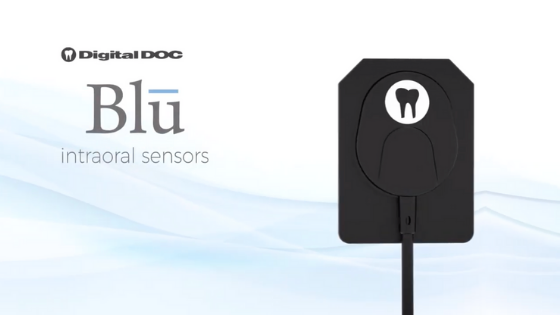Blū Digital X-ray Training
Blū Digital X-ray Training for Your Practice
Welcome to the training of Digital Doc’s Blū Digital X-ray sensor. Today, we will cover the barrier’s placement, use of the x-ray positioning system, proper placement of each type of x-ray, proper disinfection, storage, and technical support included with your sensor.
The Digital Doc Blū X-ray Sensor delivers low noise, high contrast images for fantastic diagnostic reliability. The x-rays captured on our sensors are transmitted instantly to your imaging software, where they are ready for your diagnosis.
Different Sensor Sizes
Patients come in multiple sizes, and so do our sensors. Two sensor sizes give you the flexibility to get the right image for every treatment situation.
Our size 2 sensors are standard size for adult patient bitewing x-rays and posterior periapical x-rays. Our size 1 sensor is ideal for pediatric patients, anterior PAs, and patients with a small mouth or large tori.
Barrier Placement
To prevent cross-contamination of the sensor between patients, you always want to use a barrier or sheath on the sensor before putting it into the patient’s mouth. Using the recommended barrier for your sensor, slide the sensor into the barrier, pushing it all the way to the end. Make sure that the cable is covered as well. When removing the barrier sensor, you want to make sure you avoid pulling on the cord.
Sensor Placement Per X-Ray
Now that our sensor is properly covered, we can place the sensor on our x=ray positioning device. For any radiograph, seeing the interproximal contact clearly is important for caries detection. Digital doc’s x=ray positioning system helps ensure you’re using the proper paralleling technique while acquiring your image. Place the sensor holder with the sensor’s flat side towards the ring and the corded side of the sensor toward the center of the mouth. You always want to aim the x-ray machine at the flat side of the sensor. Make sure the cord is directed out of the mouth, not towards the throat. You should be able to see the sensor directly through the ring.
Our x-ray positioning system is set for the upper right PA. Place the sensor on the lingual of the upper molars. The sensor will tilt towards the sensor o the pallet. Have the patient bite down. Make sure the ring is as close to the cheek as possible. Place the x-ray cone up to the ring.

Dental X-Ray Exposure
For lower posterior PA, retract the patient’s check for increased visibility into f the mouth. Place the sensor between the lingual side of the lower molars and tongue. Again have the patient bite down. Make sure the ring is as close to the face as possible.
For the upper anterior periapical x-ray, scoop the sensor into the mouth’s pallet and place it behind the upper anterior of the teeth. Have the patient bite down. If needed, they may use their hand to hold the bar steady. Push the ring as close to the face as possible. For the upper anterior, the ring will be very close to the nose. Line up the x-ray tube with the ring and expose the x-ray.
For horizontal bitewing x-rays, place the sensor between the tongue and the teeth. Align the front end of the sensor towards the midline to follow the mouth’s curve and help with getting open contacts on your image. Have the patient bite down. Press the ring as close to the face as possible. Line up the x-ray with the ring and expose your x-ray.
Proper Disinfection of Sensor
After you’ve removed the barrier, use recommended disinfectant wipes to wipe the sensor and cable. Ensure you are wiping towards the sensor, not away from the sensor, to ensure you are not pulling on the cord.
Storing the Sensor
A wall-mounted sensor holder is always recommended. Place the sensor in the holder and wrap the cord around so that the cord is not coiled tightly or kinked in any way.
Warranty and Technical Support
Your x-ray sensor carries a 1-year manufacturer warranty. See our website at www.digi-doc.com for warranty details and details on our extended care plan.
For sensor technical support: please call the Digital Doc Corporate office located in Northern California at 1-800-518-1102 between the hours of 9:00 am and 5:00 pm CST for any technical assistance you may have.
Subscribe to our Digital Doc YouTube channel for more videos on our Digital Doc products.

